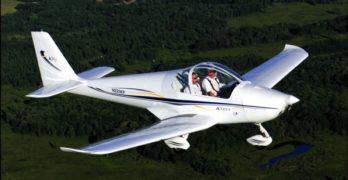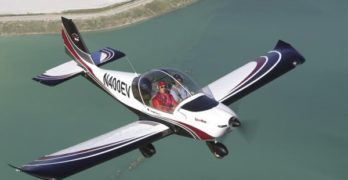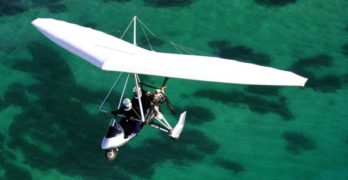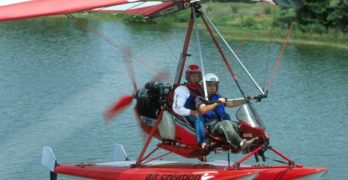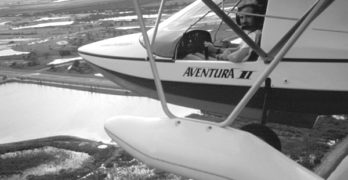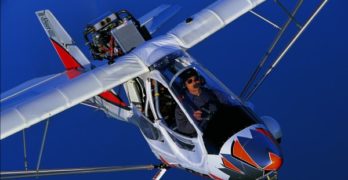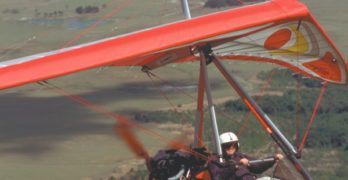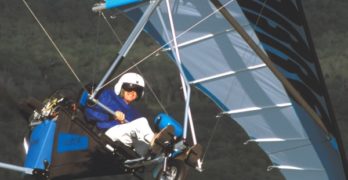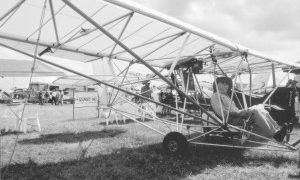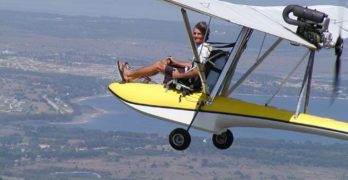Kappa’s KP-5 … a great trainer and more!
At EAA AirVenture Oshkosh
2005, 13 aircraft on
display in the Light-Sport
Aircraft (LSA) Mall-
which put LSA on center
stage just south of AeroShell Square-
had their airworthiness certificates as
special light-sport aircraft (S-LSA). (A
14th aircraft, the Savage Cub, exhibited
in the North Commercial Area,
also earned its S-LSA certificate, but
only had one aircraft to display.) That
14 aircraft earned S-LSA certificates
in the short span of three and a half
months since the FAA announced
the availability of the final consensus
standards for LSA-category airplanes
is an unprecedented accomplishment.
No one can recall when so many airplanes
have been certificated in such
a short time.
One of those baker’s dozen plus
one is the Jihlavan (pronounced
“YEE-la-von”) KP-5, better known to
Americans by its importer’s name-
Kappa Aircraft KP-5. It is an elegantly
styled, all-metal LSA with a high-visibility
cockpit, a high-performance
wing with well-regarded Fowler
flaps, tough trailing link landing
gear, and the popular Rotax 912
powerplant.
Search Results for : BRS parachute
Not finding exactly what you expected? Try our advanced search option.
Select a manufacturer to go straight to all our content about that manufacturer.
Select an aircraft model to go straight to all our content about that model.
A Sporty SportsStar: Leading the LSA Parade
Being first is often good in marketing, sports, or life in general, for that matter. In the light-sport aircraft (LSA) certification race, one aircraft has already won: the Czech Republic-built Evektor SportStar. This all-metal, low-wing, bubble-canopy design was the first aircraft to win its airworthiness certificate as a special LSA (S-LSA), and no one can ever take that distinction away.
Evektor Aerotechnik appointed Sport Aircraft International of Kerrville, Texas, as its American distributor. That company is currently in the process of transitioning to Evektor America as its new trade name. At EAA AirVenture Oshkosh 2005, it exhibited a beautifully finished SportStar SE alongside Evektor’s four-seat Cobra, which is aimed at the Cirrus market. In the LSA Mall, another SportStar presented itself to thousands of visitors.
I flew the first imported version of the SportStar, then called the EuroStar, a few years ago. The day after EAA AirVenture 2005 ended, I was delighted to join Evektor America President Jeff Conrad and rocket down Wittman Field’s runway in the newest SportStar SE (special edition).
AirBorne’s XT 912 Trike
Racing to be the first weight-shift S-LSA
In early January, the FAA accepted the ASTM consensus standards
for weight-shift control (WSC) aircraft, commonly known as trikes.
The agency’s action paved the way for trike manufacturers to certificate
ready-to-fly machines as special light-sport aircraft (S-LSA). Now,
the race is on to see which company will be the first to complete the
steps necessary to show compliance with the newly approved standards.
One company in the running is
AirBorne Australia, and it is already
accepting orders for its S-LSA model,
the AirBorne XT 912. How can it be so
confident this model will comply? Its
machines already meet Australia’s tough
certification standards, so the effort is
primarily one of paperwork. (Though
preparing documents to the FAA’s precise
requirements is no trivial task, as
anyone who has tried to correctly fill
out the sport pilot certificate application
knows.) Interestingly, Australia is
one of two nations-Colombia is the
other-that have accepted the sport
pilot/light-sport aircraft (SP/LSA) rule
as part of their national program.
Air Création’s High-Performance Floats
Air Création is a serious company and a world-class trike builder with an impressive sales record. Their serious trikes sport beautiful hardware and numerous customized components. Right down to their trademark red color, Air Création is serious about building a remarkable trike, a series of them in fact.
So when Air Création puts a float set on the market, you can count on the fact that it was well researched and exquisitely crafted.
Now, let’s combine that with the XP-17 wing, the largest in the company’s XP series. Floats are mounted under and the wing atop a GTE trike carriage which has been in production for several years. Put this all on a lake in Florida and you have the makings of an interesting experience.
Another 20-Year Veteran
Gilles Bru and Jean Yves le Bihan founded the French company in 1982. Air Création’s dealer in Canada reports, “It has grown steadily ever since, building around 4,000 wings and 2,500 trike-units for sale in more than 50 countries.”
Today Air Créationemploys 25 people, four of whom are in the technical department designing new products, and 14 work on the production of ultralight trikes and wings.With annual sales of about $2.5 million, Air Création exports 60% of its products.
Aventura II
If you’ve never flown an airplane on floats, you’ve missed a glorious experience in flying. Good as any ultralight on floats may be – and that means “quite excellent” in my opinion – even those pilots with that experience may have missed the unique sensation of a boat-hulled ultralight.
With a few thousand hours in my logbook covering everything from foot-launched hang gliders to twin-engined Barons, I can honestly say my absolute favorite hours are spent in one of two ways: first is soaring flight, but a close second is warm summer day flying in an ultralight floatplane.
It just doesn’t get any better.
Having stuck my personal opinion into this article, I must tell you about a most promising company and their 2-seat floatplane, the Aventura II. Since Arnet Pereyra exploded into the ultralight scene in 1995, this new company has filled out their line of floatplanes with a roomy and fun 2-seater which deserves a close look.
Quicksilver’s GT500 Qualifier
Quicksilver’s GT 500 is ready for sport pilots
In the automotive world, GT stands for Grand Touring and that may be an appropriate comparison for the GT 500 from Quicksilver Aircraft Manufacturing. With the unlimited view from the front seat of this tandem two-seater, touring in the GT 500 is definitely a treat.
When the sport pilot/light-sport aircraft (SP/LSA) final rule arrives on the aviation scene, this top-of-the-line model from the longtime Southern California ultralight manufacturer may well be one of the first available ready-to-fly light-sport aircraft (LSA). Quicksilver co-owner Carl von Hirsch has indicated the company will build the GT 500 as a ready-to-fly Special LSA. It will also offer the strutbraced MX Sport IIS as a LSA entry.
You might say the GT 500 is preapproved; in 1993 the tandem, two-seat aircraft received both a type and production certificate in the Primary Category (see sidebar). It’s pretty safe to say that the design will quickly pass muster under the FAA-mandated LSA consensus standards under development by ASTM International.
Clipper 912 with iXess Wing and Fun 450
After flying all their models, after visiting with company representatives on several occasions, and after visiting the factory in Aubenau, France, I feel like I know the Air Création people. So I should have known they wouldn’t just make a new wing purely for marketing reasons.
Indeed, when I few the iXess after flying their new Fun 450 wing (also reported in this article), I came away with that same head-shaking-in-wonder feeling that has affected me before. I know a little something about delta wing design, having been around hang gliding since the early 1970s, and trikes since their beginning. That helps me to comprehend how far these wings have progressed and how much harder it is to extract additional gains year after year.
Trike wings (and hang gliders) generally trade more glide or speed performance for handling ease. At least, that was how it used to be. Today, that statement must be modified to reflect the surprising capacity of modern wing designers to find more performance at the same time they refine the handling.
Sabre’s New Wildcat
Smoother and More Refined
Sabre Aircraft’s Wildcat is an evolving story of ultralight aircraft development. It also speaks to the increasing maturity of the light aviation industry.
For years, Sabre Aircraft’s sales of their various trike models may have been the largest of any U.S. manufacturer. As 2003 ended the company was reporting delivery of some 700 ultralights.
The company has long offered a good flying, simple trike with a modest price tag. Proprietor and designer Richard Helm made steady improvements to his Sabre Elite and Sabre 340 designs. But he took no major strides forward.
The vigorous pace of Sabre trike sales and the company’s need to stay on top of manufacturing issues can explain a drawn-out development period. Little time was left over for projects such as getting an entirely new trike ready for market.
That didn’t stop Helm. He kept working on elements of what would eventually become the Wildcat.
Breese HKS Sidebar
On the Horizon at M-Squared
Paul Mather has another airplane in the works at his Alabama company. Called the AeroTug, it made its first public appearance in the summer of ’03 in Wisconsin.
Once called “Breese AT,” the new entry is built by M-Squared in a deal involving former Second Chantz Aircraft Recovery Systems owner John Dunham. Dunham says he approached Mather and M-Squared. They agreed that Mather will build the customized rig and Dunham will market and distribute it.
Already very familiar with M-Squared airplanes, Dunham leases one he owns to TV production studios as a filming platform. He explains, “I’ve been working with Paul to develop a new tug ultralight to compete with the Dragonfly. We will be doing flight and hang glider tow testing in Alabama, and then I will be flying it around to all the Florida parks to show it off. I’ll be the exclusive marketing agent for this aircraft.”
In explaining his request to Mather’s company, Dunham said that he wanted it to be, “…based on the M-Squared Breese single-seat design with the 2-place, single-surface, slow, strutted wing, plus a Maule-type tow hook release under the rudder, tundra tires, and a specially-built Rotax 670 – almost 100 hp at the same weight as the Rotax 582.”
About this hybrid model Mather says, “She’ll climb all day at 25 mph while towing a hang glider.
Connie Amphib — “The Flying Float” (and it is!)
Check out Bobbie Bailey’s Connie Amphib.
Many pilots are aware of aircraft referred to as flying boats. Among ultralight aircraft, the Aventura, SeaRey and Buccaneer stand out as good examples as do trikes like Polaris’ Flying Inflatable Boat. The flying boat reference describes those aircraft built around a boat hull with substantially different structure than airplanes equipped with two floats.
That clear definition is blurred by the introduction of a novel new ultralight from the inventive mind of Bobbie Bailey. His new Connie amphibian is neither flying boat nor a float-equipped ultralight. My BRS associate, Gregg Ellsworth, tagged it a “flying float.” Works for me.
Canada’s Lotus Float company offers a single float setup that functions much the same way but is an add-on to a wheeled ultralight. This may make a perfectly fine floatplane, but you have to do the fitting yourself, and it simply won’t be as elegant as Bailey’s Connie amphib.
- « Previous Page
- 1
- …
- 12
- 13
- 14
- 15
- 16
- …
- 18
- Next Page »


